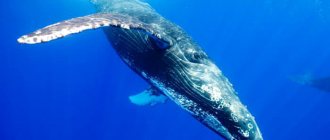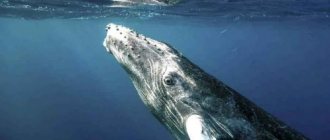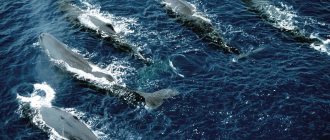Representatives of the class of mammals - whales - are marine animals that amaze with their impressive size. In Greek, the meaning of the word kitoc is “sea monster”, from which the name of this mammal comes from. In the old days, when fishermen just began to notice such a large creature as a whale, there were frequent disputes about whether it was a fish or an animal.
Surprisingly, the ancestors of all cetaceans are artiodactyl land animals. Although the whale looks like a fish in appearance, one of its modern ancestors is a hippopotamus. Currently, there is no longer any doubt that whales are marine mammals.
Whales: description
Compared to other aquatic mammals, whales breathe through lungs and are warm-blooded animals. In addition, whales feed their offspring with milk, and also boast very thick hair.
Appearance
Whales, like most inhabitants of the seas and oceans, have a spindle-shaped, streamlined body. The fins (fins) are shaped like blades. The tail ends with a fin divided into 2 parts. It is located horizontally. The tail fin serves as both a stabilizer and a motor for the animal. The movement is carried out due to the wave-like movements of the caudal fin.
Interesting to know! Whales, like dolphins, need to occasionally come to the surface of the water to fill their lungs with oxygen. Only one half of their brain can be in a sleep state.
Different cetaceans protect their body surfaces from ultraviolet radiation in different ways.
If we take blue whales, then the level of special pigments in their skin increases, which absorb UV rays very effectively. Sperm whales trigger a special kind of reaction that is similar to the response to the influence of oxygen radicals. Fin whales have learned to use both methods of neutralizing ultraviolet radiation. Living in cold waters, whales maintain their optimal body temperature with a thick layer of fat. The layer is located directly under the skin of a mammal, and serves as an effective protection against hypothermia.
Behavior and lifestyle
Scientists believe that whales are mainly active during the daytime. The cetacean order is characterized by the fact that it can remain under water for a long period of time. Some representatives of this detachment rarely use their unique capabilities, hiding in the water column only in moments of danger.
Despite this, there are also unique underwater swimmers, such as sperm whales. This representative of cetaceans dives without problems to depths of up to 2 thousand meters, or even deeper. The sperm whale is able to stay in the water column for up to an hour and a half without replenishing its lungs with a new portion of fresh air. This became possible due to the fact that the whale has simply huge lungs, and there is an increased level of hemoglobin in its blood. In addition, a high level of myoglobin is concentrated in its muscle tissue. To everything else, it should be added that the sperm whale’s body is little sensitive to an excess of carbon dioxide. Before diving, the whale breathes frequently and deeply to saturate its muscles with oxygen, after which it fills its lungs with clean air.
Whales, despite their impressive size, do not show aggression towards other inhabitants of the underwater world. Their life activity is associated with seasonal migrations, so with the onset of cold weather, whales begin to move to water areas with more comfortable living conditions. Every year they move along the same routes, so the whales know where and why they are swimming. Asian herds of fin whales feed in the Sea of Okhotsk in the summer, and with the onset of cold weather their path lies in the Yellow Sea, to the shores of Japan.
How long do whales live?
The lifespan of this family depends on its variety and size. Small cetaceans live no more than a quarter of a century, but the largest ones can live up to 50 years. The age of a whale can be determined by several signs: by the condition of the female's ovaries, by the baleen plates, by the ear plug or by the teeth.
Amazing facts about whales.
Beast or fish
The whale is the largest animal on the globe. Due to the fact that cubs are born in the same way as other mammals. The lungs are used for breathing. Based on this information, it becomes clear that this statement “a whale is a fish” is fundamentally incorrect.
@ ArtTower - pixabay.com
Types of whales
The order Cetaceans is represented by only two suborders:
- Baleen whales (Mysticeti) . The suborder of baleen whales is characterized by the presence of baleen, as well as the presence of a filter-like layer located on the upper jaw of the mammal. Baleen plays a very important role, as it provides the ruler of the seas and oceans with food, as it participates in the important filtration process. This is important for the whale, since the diet is based on various aquatic plankton. To get it, whales have to pass large volumes of water through themselves. Baleen whales in our time are the largest representatives of the cetacean order.
- Toothed whales (Odontoceti) . The suborder of odontocetes is distinguished by the presence of teeth, which makes their diet significantly different from that of baleen whales. These representatives of cetaceans hunt squid and very large fish, which form the basis of the diet of toothed whales. Another peculiarity of toothed whales is that they master the principles of echolocation. Porpoises and dolphins belong to this suborder of cetaceans.
The suborder of baleen whales consists of 4 families, such as minke whales, gray whales, right whales and pygmy whales. These families include 10 species, such as bowhead, southern, dwarf, gray, humpback, blue whale, fin whale, sei whale, Bryde's whale, and minke whale.
The toothed whale family includes:
- Gangetic dolphin.
- Dolphinaceae.
- Narwhals.
- Sperm whales.
- Anii.
- Dwarf sperm whale.
- Beaked whales.
- Laplatan dolphin.
- Porpoises.
- River dolphin.
The third suborder consisted of ancient whales, which are now considered extinct.
About copybooks My alphabet for first grade
Although there are many complaints about these copybooks, it is impossible to exclude them from the educational process in the “Perspective” program, since this program simply does not provide for any other handwriting practice. The tasks in the textbook are very simple, there is too little writing. Recipes are needed. Ideally, they would be replaced with more voluminous ones without stupid tasks, for example from the School of Russia educational complex. If possible, parents, practice with your child at home using any other copybook, where the emphasis is not on the parents’ intelligence, but on practicing the elements of letters, their connections, whole words and sentences.
If you have to study using printed notebooks “My Alphabet”, welcome to the ranks of users of our site. Click on the page numbers to find the answers you need. The pages of the solution book coincide with the pages of the copybooks.
- Forward
Whale habitat
Sperm whales today are characterized by the most extensive habitat, since they are found throughout the entire waters of the World Ocean, while they are not found in the coldest waters. The dwarf sperm whale is found in the warmest or moderately warm waters of the World Ocean.
Baleen whales inhabit the waters of various oceans, and bowhead whales live exclusively in Arctic latitudes. Bryde's minke lives in the warm zone of the World Ocean, and dwarf whales are inhabitants of cold and temperate waters of the southern hemisphere.
Fin whale
Scientific name: Balaenoptera musculus Length: up to 27 m. Weight: up to 75 tons
The fin whale, or herring whale, is the second largest animal species on the planet after the mighty blue whale. They are also fast swimmers with a maximum recorded speed of about 41 km/h.
Although fin whales are commonly recognized by their curved dorsal fin and distinctive asymmetrical body markings, they are often mistaken for blue or seismic whales. They are the closest relatives of blue whales. Sometimes hybrids between these species are even found.
Cosmopolitan fin whales are found in all climate regions (except the polar extremes).
19
What do whales eat?
The diet of cetaceans is based on various food components, depending on habitat conditions and time of year. In addition, each subspecies has its own gastronomic preferences. Bowhead whales, which are planktivores, feed in the upper layers of open waters, where they catch zooplankton in the form of small crustaceans and pteropods. Gray whales, which are benthophagous whales, feed at shallow depths, and ichthyophagous whales prey on small schooling fish. Minke whales prefer a mixed diet, so their diet includes all kinds of crustaceans and fish. Sperm whales, beaked whales and gray dolphins, which are teutophagous, feed exclusively on cephalopods.
The seasonal nature of cetacean feeding allows them to gain fat. This is typical for the end of autumn, therefore during the winter period they spend part of their fatness and by the spring they have the least weight. When whales reproduce, some species do not eat food at all.
THIS IS WHAT HAPPENS WHEN A WHALE EATS. This huge whale shocked everyone when it swallowed a man
Short-finned pilot whale
Scientific name: Globicephala macrorhynchus Length: about 5.5 m Weight: about 3 tons
Due to their small distribution, short-finned pilot whales are still very little studied. They have a small jaw and short, rounded fins. The color is gray-blue with numerous white spots or scars throughout the body. The shape of the dorsal fin can differ from one individual to another, as it is determined by age and sexual orientation (Yes, this occurs among whales).
10
Reproduction and offspring
Almost all whale species reproduce in warmer waters. Despite the fact that some species prefer to live in colder conditions, they migrate and their reproduction process occurs in the winter, in warmer climates.
Interesting moment! Baby whales are not only impressive in size, but also fully formed, ready to live in the water column. This is due to the fact that such aquatic animals do not have pelvic bones as such, so there are no restrictions on the maximum size of the fetus.
Female whales carry their offspring for 9 to 16 months, depending on the species. As a rule, only one whale emerges into the light, tail first. After birth, the calf floats to the surface of the water, where it takes its first breath. The offspring quickly adapt to new living conditions, demonstrating confidence and swimming skills. They try to stay close to their mother, which greatly facilitates the process of moving and also serves as protection from natural enemies.
The newly born offspring feed quite often, sucking on the mother's nipple almost every 15 minutes. It should be noted that the baby whales do not have to strain particularly hard to get a portion of milk, since it is itself injected into the cubs’ mouths, due to the contraction of special muscles. Depending on the size of the mammal, the amount of milk can vary and its volume can range from 200 ml to 200 liters.
Cetacean milk is quite thick, creamy in color and almost 10 times more nutritious than regular cow's milk. Thanks to its special properties, this milk does not spread in water. The mother feeds her cubs with milk for 4 months or almost a whole year. Often she stops feeding the baby milk because she is pregnant again.
Whales have a well-developed sense of parental instinct, so whales never leave their young in danger. If at low tide a baby whale suddenly finds itself in shallow water, the female will always wait until high tide to pick up her baby and take him to a safe place. Adult whales always bravely rushed towards the calves that were hit by the whalers' harpoons, trying to pull them away from the ship. Man took advantage of such boundless devotion of whales and thus lured adult individuals.
It is important to know! Beluga whales are easy to train, so they can be seen in various dolphinariums and circuses. The babies of these whales are the most highly valued.
Whales are characterized by the fact that they are very touching not only towards their own young, but also towards the young of their relatives. Almost all representatives of the cetacean order will never leave their wounded or sick brothers in trouble, trying to help them.
A whale that is too weak, if it does not have the strength to rise to the surface of the water to take a breath of air, is helped by healthier relatives. They surround the weak whale and help it rise to the surface. After that, they support it until the whale takes in enough air.
Lifestyle
You can briefly describe the character and lifestyle of the mammal in an essay or report about the blue whale. Animals swim alone or in pairs. If they find plankton habitats, they gather in small groups. But the whales practically do not communicate, and after feeding they disperse.
Mammals love depth and space; they are practically never found near the coast. In their free time, they simply drift from one feeding site to another. The average speed of movement is 10 km/h. But if a whale is frightened by something, then it swims faster - up to 30-40 km/h. Although such a race requires significant energy expenditure.
The animal needs careful preparation before a serious dive. The vomit takes a deep breath, dives under the water 8-10 times, and then emerges. Only after this does it dive to 100-200 m . If a mammal is frightened, it can go 500 m underwater. And after about 15-20 minutes the whale rises to the surface and releases a fountain of air.
He remains above the water for some time to breathe calmly. After this, the animal goes deeper again. Long-term dives require enormous physical effort. The whale can hide from its enemies or hunt plankton at great depths for 30-40 minutes.
Natural enemies of whales
Active cetacean fishing is considered the main factor that influences whale mortality. Despite this, cetaceans suffer from various severe parasitic infestations. Quite often, animals suffer from skin ailments, including ulcers, fungal infections, and malignant neoplasms in the form of acne. There are frequent cases of skeletal damage, in the form of severe bone tumors, as well as complex bone growths.
The problems of large marine inhabitants do not end there, since jaw distortions are possible, as well as dental problems, muscle problems, tumors and abscesses of the lungs, purulent pneumonia, cirrhosis of the liver, gastric ulcers, stones in the ureters, and contact infectious diseases.
Quite often, small species of whales, as well as dolphins, die in fights with killer whales. All sorts of parasites, such as trematodes, cestodes and nematodes, cause great damage to the overall number of whales. Barnacles, as well as whale lice, are considered the most common ectoparasites of the order Cetaceans.
sei whale
Scientific name: Balaenoptera borealis Average length: up to 18 m. Weight: about 20 tons
The sei whale is a large species in the genus Balaenoptera (like fin whales). They have a bluish-gray color. Externally they are distinguished by a pointed rostrum (the front part of the whale's mouth, including the jaw) and an arched dorsal fin. Sei whales often have scars all over their bodies. These scars are believed to have been caused by shark bites.
Sei whale populations are often subject to mass mortality. One such event occurred in June 2015, when approximately 337 dead whales were discovered in a remote area of Patagonia in Chile. The cause of their death has not yet been determined, however, scientists believe that this is due to severe pollution of the habitat (possibly an oil leak).
Population and species status
It should be noted that the populations of the cetacean order are declining from year to year, and at a tremendous rate. Many factors contributed to this, such as significant changes in habitat with significant degradation, as well as thoughtless fishing just for the sake of extracting whale oil or whalebone. Today, Gangetic dolphins are so small in number that they are listed in the International Red Book under the status of “Endangered Species”. The total number of Pacific gray whales is only a few hundred individuals, with only two dozen females. February 19 is considered World Whale Day, as on this day in 1986, all commercial whale hunting activities were banned.
Therefore, in our time, any hunting of many species of whales that are on the verge of extinction is prohibited. Such marine inhabitants include the blue whale, bowhead whale, gray and humpback whale. They have suffered quite seriously due to mindless harvesting for fat.
The Red Book of Russia includes such species of whales as the small killer whale, 3 species of dolphins, the Black Sea bottlenose dolphin, the porpoise, the narwhal, as well as many species of the cetacean order. In fact, listing many animals in the Red Books does not in any way guarantee their protection from complete extinction.
Social structure
Information about vomits is contained in most animal encyclopedias. Educational texts talk about the social structure of mammals. Animals communicate with their relatives using powerful infrasound signals. This is how they inform relatives at great distances—thousands of kilometers—that everything is fine with them.
Whales are monogamous and swim in pairs for decades. They have a young every two years . For about 6 months, his mother feeds him full-fat milk, which allows him to gain 100 kg every day. Whales begin to hunt on their own at four years of age, but their growth continues until they are 15 years old.
For hundreds of years, scientists have been interested in the life of vomits. They never reached a consensus on the duration of their existence. Whales live a minimum of 40 years, but the maximum could not be calculated. Researchers believe that some individuals are up to 100 years old.
Whales and man
Man began to hunt whales the moment he learned to use various watercraft. When catching whales, people obtained a lot of fat, a lot of bones and highly valuable whalebone. Such hunting continues today, despite existing prohibitions. Lard and fat are used to make margarine, glycerin and soap, and whale bones are used to make all kinds of jewelry, corsets, dishes, figurines and other crafts, which are highly valued among tourists.
Naturally, whale meat is also used. Various dishes are prepared from it, as well as sausages, sausages, cutlets, pates and jellied meat. Various healthy and tasty canned foods are also prepared from whale meat.
Important point! Many countries have significantly limited the harvest of whales, not only for industrial purposes, but also for the needs of research centers, including the needs of indigenous peoples.
This Man Was Swallowed by a Whale, But What Happened Next Amazed Everyone
Belukha
Scientific name: Delphinapterus leucas Length: about 5.5 m. Weight: about 1.9 tons
The beluga whale is an unusual animal; in appearance it is something between a whale and a dolphin, although according to the classification, it is a toothed whale, related to the narwhal. Surprisingly, beluga whale calves are born dark blue and begin to turn white when they reach sexual maturity. Beluga whales do not have a dorsal fin and, which is unusual for other whale species, can turn their heads to the sides.
An interesting fact: beluga whales remember well the place where they were born and, every year, during seasonal migration, they try to return “to their homeland.”
Beluga and beluga are completely different species of animals.
14
Africa
Where do whales live in Africa? These giant animals hold entire “festivals” that can be seen in South Africa near the city of Hermanus. They come here to give birth to their babies. Here the mothers remain until the cubs grow up.
To admire the whales, there are observation decks on the shore of the bay. From them you can clearly see the pirouettes the whales make in the bay. It is common to see 20 or more individuals jumping. This spectacle attracts tourists from all over the world. The city even has the profession of a whale keeper, whose duties include notifying where these animals can be expected.
Greenland
The real kingdom of whales is Greenland. In addition, you can meet walruses and polar bears here. Aasiaat, a city nicknamed the whale capital, is considered the ideal place to observe giant aquatic mammals.
Whale sightings are most common from June to September, when the water is warmest.











